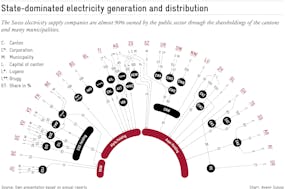Flying to the moon, becoming the world’s most populous country, excellent growth forecasts: India is playing an increasingly important role on the world stage.
With this in mind, the interest of the EFTA states (Switzerland, Norway, Iceland and Liechtenstein) in a trade agreement with India is understandable. After 16 years and 21 rounds of negotiations, India and the EFTA signed a Trade and Economic Partnership Agreement (Tepa) in March led by Switzerland. The Federal Council initiated the ratification process this week by adopting the dispatch.
Is this a success for Switzerland and its free trade policy geared towards various partners? Yes, because India’s economic potential is enormous. However, this two-part blog takes a closer look and dedicates the first part to the somewhat idiosyncratic investment promotion chapter in the Tepa. The second blog then focuses on the “classic” elements of a free trade agreement, i.e. trade in goods and services.
Eternal beacon of hope?
“I’m going (to India) because it is the biggest democracy in the world, and I think we haven’t been working with them enough.” This quote comes from Bill Clinton, who in 2000 became the first US president in 22 years to visit India and regretted that he had paid too little attention to this country.
India is attractive to Western countries thanks to its impressive economic growth and young population. The country is soon set to become the third largest economy after the USA and China.

Flying to the moon, becoming the world’s most populous country, excellent growth forecasts: India is a country of contrasts. (Adobe Stock)
A glance at the figures alone speaks volumes: the average age of the 1.4 billion inhabitants is 30 years, the gross domestic product adjusted for purchasing power is USD 9279 billion and the growth rate is over 7 percent (2022).
Modi wants to “Make in India”
In order to maintain growth, a large majority of this young population would have to switch from the dominant agricultural sector to industry or the service sector. However, according to a report by the International Labor Organization (ILO), India has great difficulties in integrating young adults into the labor market, which is due to a lack of training and further education opportunities, for example.
Another explanation could be the lack of jobs for low-skilled workers due to the underdeveloped industrial sector. So far, India has largely made the transition from an agricultural economy to a service economy without taking the “detour” of building up large-scale industrial production. In fact, many young people have returned to the countryside in recent years to work on their parents’ farms.
In this context, the “Make in India” initiative launched in 2014 aims to boost investment and promote innovation. India is to become the new business hub. However, the initiative is anything but a success. The target of increasing the share of manufacturing industry to a quarter of GDP by 2022 was clearly missed by ten percentage points.
In addition, the government is guilty of contradictions that have mercantilist overtones: despite generous subsidies to make production in India more attractive, it has constantly increased the cost of intermediate product imports over the past 30 years.
In terms of trade, India concentrates on concluding bilateral agreements and (for the time being) refrains from participating in major regional or trans-regional agreements such as the Regional Comprehensive Economic Partnership (RCEP) or the Comprehensive and Progressive Agreement for trans-Pacific Partnership (CPTPP).
Unconventional investment promotion
These industrial policy ambitions also explain why the Indian government declared the investment promotion chapter to be a “sine qua non” in the negotiations. In it, the EFTA states commit to investing 100 billion US dollars and creating one million jobs by 2040.
This is no small sum when you consider the figures from the Indian Ministry of Commerce. Since the turn of the millennium, the EFTA states have invested almost 11 billion US dollars in India. More than half of this amount has been invested in the last five years. An independent review procedure is to guarantee investments. At the highest escalation level, India is likely to withdraw its concessions on trade in goods.
These specific requirements represent a novelty in trade policy. There is no doubt that these commitments seem unconventional, as neither the EFTA nor its member states can promise private investment. The example should therefore not become the norm. Nevertheless, a footnote specifies that India should be able to maintain a GDP growth rate of 9.5 percent over the next 15 years in order to achieve the objectives set.
In terms of realpolitik, however, this appears to be a pragmatic bet. Concluding the Tepa before India reaches an agreement with the UK or the EU could give India a competitive advantage. Moreover, the additional expansion of the Swiss free trade network – with Ecuador (2020), Indonesia (2021) and the UK (2021) – promises to make Switzerland more resilient in difficult geopolitical times. Switzerland’s free trade agreements now cover 77 countries and around 55 percent of the global market.
India’s challenges
Whether Swiss entrepreneurs can actually invest the specified sums and create jobs also depends on whether India does its homework. The country faces major problems in education, for example. According to the World Bank, the illiteracy rate is 24 percent. There is also a need to catch up in terms of infrastructure and reducing bureaucracy, including the granting of licenses to foreign companies.
Another obstacle is the ethno-nationalist ideas propagated by Prime Minister Modi’s Bharatiya Janata Party (BJP). The BJP missed out on an absolute majority in the elections. This means that it cannot single-handedly change the constitution and the minority rights enshrined in it. This at least gives hope for a certain stability and predictability in the political environment.
Despite everything, the EFTA states are counting on India’s positive economic and social development. Only with this in mind is it easy to understand that they have agreed to such an unusual agreement, and it remains to be seen whether India can win the trust of investors with the necessary reforms.
Part 2: Swiss concessions to India





